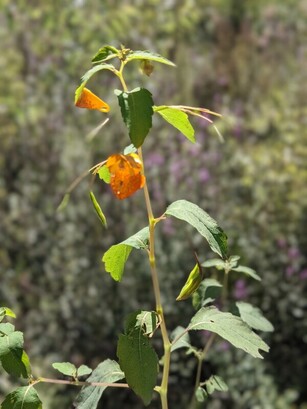CONSERVATION CORNER
A weekly blog for all things conservation
 Jonathan VanNoy, Natural Resource Specialist, BCCD Recently I was working out in one of our local streams, and I was observing some of the vegetation that was growing on the stream banks and even in the stream channel itself. Several plants stood out; raspberries hung heavy on their prickly stems, and the bank I stood beside was woven with broad, three-pointed green leaves and large, five petaled purple flowers. These were identified through a cell phone app as flowering raspberries- a surprise to me! However, the main plants that drew my attention (maybe because we practically had to wade through them) were the masses of Jewelweed, which sprawled from water’s edge all the way across beds of gravel to the foot of the stream banks. Sights of Jewelweed always take my mind’s eye back to my childhood. Playing in the small creek in the woods below my house, and around our pond went hand in hand with this shade and moisture loving plant. As young kids, we LOVED to find jewelweed when the seed pods were ripe. The green, translucent skin of the pod was stretched taut over the brown seeds inside, and at the slightest touch would explode (sometimes even jostling the plant by touching the leaves near the seed pod would be enough to set one off!) and scatter the seeds through the plant and on the ground around it. This is endless fun to every kid that I have seen discover these “poppers”… I still have a hard time passing by without busting a few seed pods! Dispersion of the seeds through these little explosions is the primary way that these plants spread. The way these pods pop and scatter seeds has earned jewelweed several nicknames, including “Impatience” and “Touch-Me-Not”.
We also were told that the sap of this plant helped relieve pains from bee stings and stinging nettles. I later found out that it is commonly believed to help with poison ivy rash, as well as a few other common ailments. I haven’t personally tried it on ivy rash, but used it plenty of times on stinging nettle injuries as a kid, and also soothed many an itchy mosquito bite with it. I always thought it was convenient that nettles and jewelweed seemed to grow in very close proximity to each other! The “juice” inside these plants is pretty easy to obtain for application on injuries as well. The plant’s joints are bulbous in appearance, and the soft, translucent green stalks/stems/joints can easily be mashed up or twisted by hand to produce the clear, healing, watery “juice” that we applied to our various hurts. More recently, I learned that jewelweed seeds are not only edible, but very flavorful (although collection when they are ripe can be a little bit tricky, due to their explosive attributes as mentioned earlier!). When the seeds inside the pods turn brown they are ready to eat, and have a very rich, nutty flavor. While I was observing these plants again during my survey, I noticed that many of the plants had been trimmed off about two feet from the ground. Normally jewelweed tops out at 4-5 feet in height. I did a quick web search and confirmed my suspicions that jewelweed is a preferred browse plant for deer. My quick search also informed me that mice and birds also scavenge the seeds as part of their food source, and that they are also often pollinated by butterflies, bees, and hummingbirds! Next time you are outdoors and see jewelweed, take a minute and check them out! Maybe try some of the now ripe seeds, check for wildlife using the plant, or take yourself back to your childhood and pop some of those green pods!
0 Comments
Leave a Reply. |
AuthorsVarious staff at the Bradford County Conservation District Archives
July 2024
Categories
All
|
|
Bradford County Conservation District
Stoll Natural Resource Center 200 Lake Road, Suite E | Towanda PA 18848 Phone: (570)-485-3144 |
